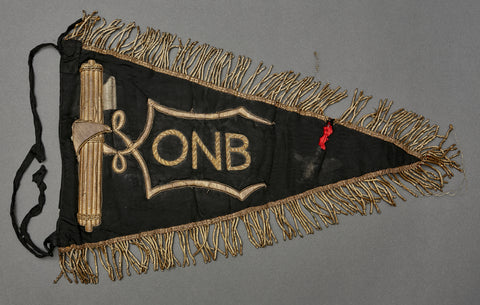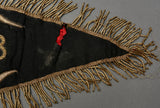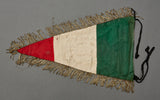Early Italian Youth Fascist ONB Flag-This pennant is constructed out of a black silk and is hand embroidered on one side with the ONB logo in a beautifully toned gold bullion with a very ornate fascist bundle applied to the left of the script. The reverse of the pennant has the three colors of the Italian flag also applied separately in silk. The colors are still vibrant, though the white does have some age discoloration. There are also some tears on the flag side, and one fairly substantial tear on the black side. Slight staining on both sides as well. This pennant measures 10” wide and 17” long, 18” with gold fringe. Gold fringe surrounds the top and bottom of this pennant, and there are black ties on the fly end of the pennant for hanging. Very ornate and interesting collectible.
History: (ONB) was an early Italian Fascist youth organization functioning between 1926 and 1937. The ONB takes its name from Balilla, the nickname of Giovan Battista Perasso, a Genoese boy who, according to local legend, started the revolt of 1746 against the Habsburg forces that occupied the city in the War of the Austrian Succession. Perasso was chosen as the inspiration for his supposed age and revolutionary activity, while his presence in the fight against Austria reflected the irredentist stance taken by early Fascism, and Italy's victories in World War I.
The ONB was established by law as an institution under the control of the Ministry of National Education in 1926. Initially, membership was voluntary, but it was later made compulsory for boys between the ages of 6 and 18 and girls between the ages of 8 and 14. In 1936, a pre-Balilla kindergarten was established for children under the age of 6. ONB members were required to study military science and Italian history. The ONB later became the GIL (Gioventù Italiana del Littorio)
The GIL (Italian Youth of the Lictor). was the consolidated youth movement of the National Fascist Party of Italy that was established in 1937 to replace the (ONB). It was created to supervise and influence the minds of all youths, that was effectively directed against the influence of the Catholic Church on youths.





